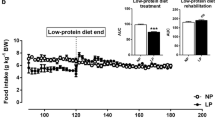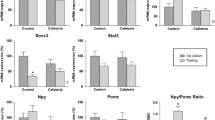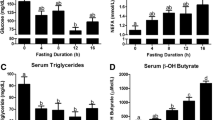Abstract
Purpose
Recent studies suggest that nutritional status during developmental periods is associated with subsequent development of metabolic abnormalities. In this study, we examined whether malnutrition by fasting for 3 days during the suckling–weaning transient period induces subsequent development of metabolic abnormalities in rats.
Methods
Male Sprague–Dawley rats were fasted for 3 days during the suckling–weaning transient period. They are subsequently fed a high-fat, high-sucrose (HF) or low-fat, high-starch (LF) diet for 14 weeks from 17 weeks of age, and the liver and blood samples were collected for measuring mRNA and protein levels of metabolic genes and blood concentrations of glucose and insulin, respectively.
Results
Fasting for 3 days during the suckling–weaning transient period induced impaired glucose tolerance in rats fed the LF diet in adulthood. Liver triglycerides in rats fed the HF diet in adulthood increased to 140 % in rats fasted for 3 days during the suckling–weaning transient period compared with those non-fasted. Furthermore, liver expression of FBP1 and ACCα genes in adult rats fed the LF diet increased to 125 and 145 %, respectively, in rats fasted for 3 days during the suckling–weaning transient period compared to non-fasted rats. PEPCK1 protein expression levels in rats fed the LF diet were higher in rats fasted for 3 days during the suckling–weaning transient period than in non-fasted rats.
Conclusion
Fasting for 3 days in rats during the suckling–weaning transient period enhances metabolic abnormalities in animals fed a HF or LF diet in adulthood by confounding metabolism of lipid and sugar in the liver.




Similar content being viewed by others
References
Manrique C, DeMarco VG, Aroor AR, Mugerfeld I, Garro M, Habibi J, Hayden MR, Sowers JR (2013) Obesity and insulin resistance induce early development of diastolic dysfunction in young female mice fed a Western diet. Endocrinology 154(10):3632–3642. doi:10.1210/en.2013-1256
Haslam DW, James WP (2005) Obesity. Lancet 366(9492):1197–1209. doi:10.1016/s0140-6736(05)67483-1
Jazet IM, Pijl H, Meinders AE (2003) Adipose tissue as an endocrine organ: impact on insulin resistance. Neth J Med 61(6):194–212
Choi S, Choi Y, Choi Y, Kim S, Jang J, Park T (2013) Piperine reverses high fat diet-induced hepatic steatosis and insulin resistance in mice. Food Chem 141(4):3627–3635. doi:10.1016/j.foodchem.2013.06.028
Nishi Y, Fukushima M, Suzuki H, Mitsui R, Ueda N, Taniguchi A, Nakai Y, Kawakita T, Kurose T, Seino Y, Yamada Y (2005) Insulin secretion and insulin sensitivity in Japanese subjects with impaired fasting glucose and isolated fasting hyperglycemia. Diabetes Res Clin Pract 70(1):46–52. doi:10.1016/j.diabres.2005.02.015
Sun Y, Liu S, Ferguson S, Wang L, Klepcyk P, Yun JS, Friedman JE (2002) Phosphoenolpyruvate carboxykinase overexpression selectively attenuates insulin signaling and hepatic insulin sensitivity in transgenic mice. J Biol Chem 277(26):23301–23307. doi:10.1074/jbc.M200964200
Roseboom T, de Rooij S, Painter R (2006) The Dutch famine and its long-term consequences for adult health. Early Human Dev 82(8):485–491. doi:10.1016/j.earlhumdev.2006.07.001
Huang C, Li Z, Wang M, Martorell R (2010) Early life exposure to the 1959–1961 Chinese famine has long-term health consequences. Journal Nutr 140(10):1874–1878. doi:10.3945/jn.110.121293
Mothers’ and Children’s Health and Welfare Association (2006) The main statistics of maternal and child health. Mothers’ and Children’s Health Organization Co. Ltd, Tokyo
Simmons RA, Templeton LJ, Gertz SJ (2001) Intrauterine growth retardation leads to the development of type 2 diabetes in the rat. Diabetes 50(10):2279–2286
Vuguin P, Raab E, Liu B, Barzilai N, Simmons R (2004) Hepatic insulin resistance precedes the development of diabetes in a model of intrauterine growth retardation. Diabetes 53(10):2617–2622
Garofano A, Czernichow P, Breant B (1997) In utero undernutrition impairs rat β-cell development. Diabetologia 40(10):1231–1234. doi:10.1007/s001250050812
Garg M, Thamotharan M, Dai Y, Thamotharan S, Shin BC, Stout D, Devaskar SU (2012) Early postnatal caloric restriction protects adult male intrauterine growth-restricted offspring from obesity. Diabetes 61(6):1391–1398. doi:10.2337/db11-1347
Henning SJ (1981) Postnatal development: coordination of feeding, digestion, and metabolism. Am J Physiol 241(3):G199–G214
Lowry OH, Rosebrough NJ, Farr AL, Randall RJ (1951) Protein measurement with the Folin phenol reagent. J Biol Chem 193(1):265–275
Chomczynski P, Sacchi N (1987) Single-step method of RNA isolation by acid guanidinium thiocyanate-phenol-chloroform extraction. Anal Biochem 162(1):156–159. doi:10.1006/abio.1987.9999
Garg M, Thamotharan M, Dai Y, Lagishetty V, Matveyenko AV, Lee WN, Devaskar SU (2013) Glucose intolerance and lipid metabolic adaptations in response to intrauterine and postnatal calorie restriction in male adult rats. Endocrinology 154(1):102–113. doi:10.1210/en.2012-1640
Michael MD, Kulkarni RN, Postic C, Previs SF, Shulman GI, Magnuson MA, Kahn CR (2000) Loss of insulin signaling in hepatocytes leads to severe insulin resistance and progressive hepatic dysfunction. Mol Cell 6(1):87–97
Hanson RW, Reshef L (1997) Regulation of phosphoenolpyruvate carboxykinase (GTP) gene expression. Annu Rev Biochem 66:581–611. doi:10.1146/annurev.biochem.66.1.581
Cassuto H, Kochan K, Chakravarty K, Cohen H, Blum B, Olswang Y, Hakimi P, Xu C, Massillon D, Hanson RW, Reshef L (2005) Glucocorticoids regulate transcription of the gene for phosphoenolpyruvate carboxykinase in the liver via an extended glucocorticoid regulatory unit. J Biol Chem 280(40):33873–33884. doi:10.1074/jbc.M504119200
Mutel E, Gautier-Stein A, Abdul-Wahed A, Amigo-Correig M, Zitoun C, Stefanutti A, Houberdon I, Tourette JA, Mithieux G, Rajas F (2011) Control of blood glucose in the absence of hepatic glucose production during prolonged fasting in mice: induction of renal and intestinal gluconeogenesis by glucagon. Diabetes 60(12):3121–3131. doi:10.2337/db11-0571
Baserga M, Hale MA, McKnight RA, Yu X, Callaway CW, Lane RH (2005) Uteroplacental insufficiency alters hepatic expression, phosphorylation, and activity of the glucocorticoid receptor in fetal IUGR rats. Am J Physiol Regul Integr Comp Physiol 289(5):R1348–R1353. doi:10.1152/ajpregu.00211.2005
Bertram C, Trowern AR, Copin N, Jackson AA, Whorwood CB (2001) The maternal diet during pregnancy programs altered expression of the glucocorticoid receptor and type 2 11β-hydroxysteroid dehydrogenase: potential molecular mechanisms underlying the programming of hypertension in utero. Endocrinology 142(7):2841–2853. doi:10.1210/endo.142.7.8238
Lillycrop KA, Phillips ES, Jackson AA, Hanson MA, Burdge GC (2005) Dietary protein restriction of pregnant rats induces and folic acid supplementation prevents epigenetic modification of hepatic gene expression in the offspring. J Nutr 135(6):1382–1386
Lillycrop KA, Slater-Jefferies JL, Hanson MA, Godfrey KM, Jackson AA, Burdge GC (2007) Induction of altered epigenetic regulation of the hepatic glucocorticoid receptor in the offspring of rats fed a protein-restricted diet during pregnancy suggests that reduced DNA methyltransferase-1 expression is involved in impaired DNA methylation and changes in histone modifications. Br J Nutr 97(6):1064–1073. doi:10.1017/s000711450769196x
Drake AJ, McPherson RC, Godfrey KM, Cooper C, Lillycrop KA, Hanson MA, Meehan RR, Seckl JR, Reynolds RM (2012) An unbalanced maternal diet in pregnancy associates with offspring epigenetic changes in genes controlling glucocorticoid action and foetal growth. Clin Endocrinol 77(6):808–815. doi:10.1111/j.1365-2265.2012.04453.x
Tenore A, Parks JS, Gasparo M, Koldovsky O (1980) Thyroidal response to peroral TSH in suckling and weaned rats. Am J Physiol 238(5):E428–E430
Acknowledgments
This work was supported by a Grant-in-Aid for Young Scientists (22680054), a grant from the Mishima Kaiun Memorial Foundation and for Scientific Research (23300276) from the Ministry of Education, Culture, Sports, Science and Technology of Japan.
Conflict of interest
There are no conflicts of interest in this study.
Author information
Authors and Affiliations
Corresponding author
Rights and permissions
About this article
Cite this article
Ikeda, M., Honma, K., Mochizuki, K. et al. Fasting for 3 days during the suckling–weaning transient period in male rats induces metabolic abnormalities in the liver and is associated with impaired glucose tolerance in adulthood. Eur J Nutr 55, 1059–1067 (2016). https://doi.org/10.1007/s00394-015-0919-9
Received:
Accepted:
Published:
Issue Date:
DOI: https://doi.org/10.1007/s00394-015-0919-9




